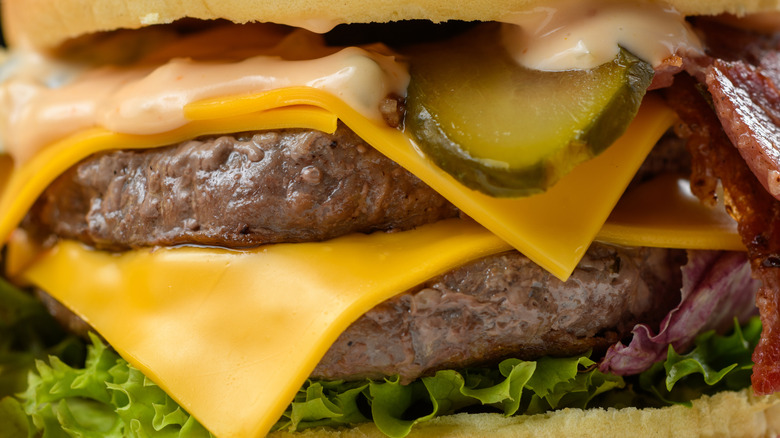Have Fast Food Burgers Really Gotten Smaller?
In recent years, prices may not necessarily be going up (though they often are), but people are noticing that the sizes of products have gotten smaller. This is a concept called shrinkflation, and it's another way big brands are cutting corners and making more money for less product. Consumers are on to these new tactics, which may be why people are wondering if fast food burgers have shrunken in size as well. The short answer is no, they have not, and in some cases, burgers have even increased in size.
Although it seems like this is a new trend, many have traced this deceptive practice as early as 1988 when the Chock Full o' Nuts coffee brand reduced its one-pound coffee canister to 13 ounces. With the rise of people talking about shrinkflation on social media, consumers are on the lookout for prices remaining the same but products getting smaller. Whether it's bread rolls at Texas Roadhouse or shrinking soda cans, the public is on watch, but they can breathe easy knowing fast food burgers are not included in this batch. Instead, some fast food places are insisting that their burgers have, instead, increased in size.
In 2023, both Wendy's and McDonald's were sued for allegedly falsely advertising their burger sizes in photos that made the burgers look more appealing than they are. The case was dismissed when the judge found that as long as the caloric content and the weight of burgers remained the same, consumers were not being deceived if the pictures of the products looked more appetizing. However, a case started against Burger King in 2022 for the same reason is moving forward.
How sizes can stay the same while quality plummets
Just because a judge found that there was no false advertising doesn't mean these companies are not cutting corners. To respond to suspicions of foul play, an ex-McDonald's corporate chef, Mike Haracz, shared a series of loopholes McDonald's could potentially use to cut costs but still claim its burgers are the same size. Some of these loopholes include decreasing the lean-to-fat ratio on the ground beef or mixing frozen meat with their fresh, never-frozen meat. McDonald's could also reduce its specification range, or range for error regarding weight, to ensure each patty hits four ounces. Haracz suggested this could be 4 to 4.25 ounces reduced to something like 4 to 4.15 ounces as a cost-saving measure (per TikTok).
On different corners of the internet, consumers are still being vigilant against shrinkflation. While there are theories about the Whoppers at Burger King having reduced in size, this discussion isn't exclusive to just burgers. There's speculation that Taco Bell's tacos and burritos are smaller with less filling, Chick-fil-A has trimmed their strips and nuggets, and both Wendy's and KFC have been called out for shrinking their drink sizes as part of menu overhauls. The Food Republic team could not find any concrete evidence to support these fast food claims, per se, but individual accounts from people who claim to work for places like Wendy's indicate sizes have been shrinking — for years (via Reddit).
Regardless, current McDonald's CEO Chris Kempczinski stated his desire to stand out in the U.S. markets by selling larger patties (via CNN). Whether it's by size, it's clear McDonald's needs a shake-up to improve its ranking for the best fast food burger.


